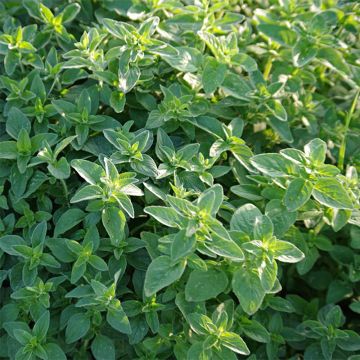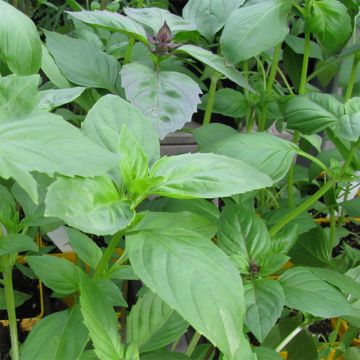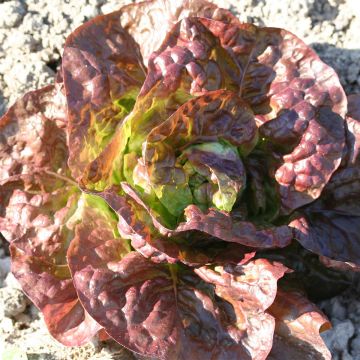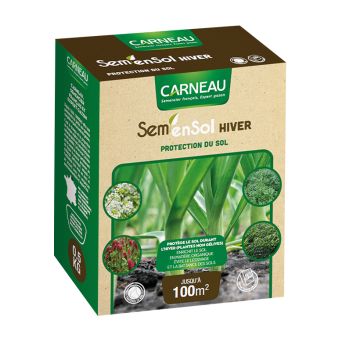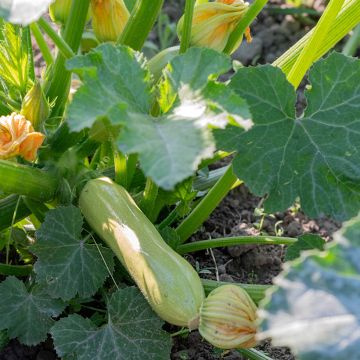

Organic Anise - Ferme de Sainte Marthe
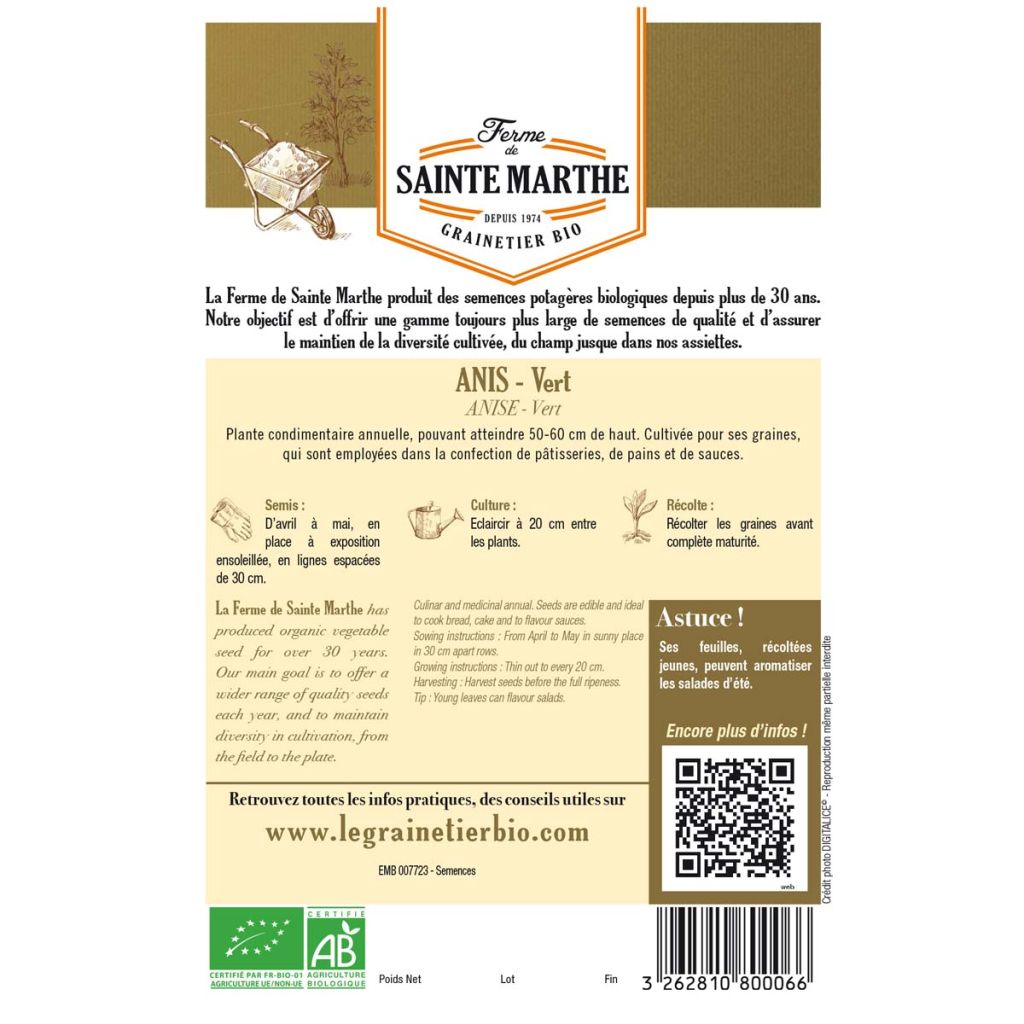

Organic Anise - Ferme de Sainte Marthe
Organic Anise - Ferme de Sainte Marthe
Pimpinella anisum
Aniseed, Green Anise, Sweet Cumin
This item cannot be shipped to the selected country
Dispatch by letter from €3.90
More information
Schedule delivery date,
and select date in basket
This plant carries a 6 months recovery warranty
More information
We guarantee the quality of our plants for a full growing cycle, and will replace at our expense any plant that fails to recover under normal climatic and planting conditions.
Seed-only orders are dispatched by sealed envelope. The delivery charge for seed-only orders is €3.90.

Description
Anise (Pimpinella anisum), also known as green anise, aniseed, or sweet cumin, is an annual herbaceous plant. It is cultivated for its very aromatic leaves and seeds which bring flavour to salads, sauces and stews.
The erect plant has hollow, hairy stems which grow to about 40 to 80 cm in height. The shape of the leaves varies: those at the base are heart-shaped while those at the top are divided into numerous small leaflets.
The flowers are small, white and grouped into umbels. The fruit is grey-green, small, dry and oval. It is slightly ribbed and pubescent, like the stems.
Anise is a popular spice. Its fresh or dried leaves can be used in salads, marinades or sauces to accompany meat or fish. Its seeds are commonly used in preserves.
Aniseed contains anethole-based essential oil, sesquiterpenes and phenolic acids. It can be used to relieve indigestion. It also has antibacterial, expectorant, antispasmodic and antifungal properties.
Harvesting: harvest the leaves when required during the growing season; the seeds can be collected in late summer, early autumn.
Preservation: anise leaves and seeds can be dried, crushed and stored in airtight boxes for later use.
Good to know: anise is a sun-loving plant. If your soil is too compact, amend it with sand, soil and compost. Anise can be used to ward off aphids, caterpillars and worms.
NB. Organic seeds (in French "AB" for "Agriculture Biologique") are produced from plants that aren't treated with phytosanitary products (insecticides, weed killers). The seeds do not undergo post-harvest treatment. They carry the AB label and are approved by Ecocert, an independent structure.
Report an error about the product description
Harvest
Plant habit
Foliage
Botanical data
Pimpinella
anisum
Apiaceae
Aniseed, Green Anise, Sweet Cumin
Cultivar or hybrid
Annual
Other Herb seeds
Planting and care
Sowing:
Anise likes fresh, loose and humus-rich soil and plenty of sun. Its stems tend to flatten if exposed to strong winds. Grow in the vegetable garden, garden borders, flower beds or pots.
Sow in the Spring, from February onwards in a cold frame or in place from April until the beginning of summer. Sow lightly in shallow furrows, about 10 cm wide and 2 cm deep. Space the rows about 25 cm apart. Cover the seeds with soil and water. Germination takes between 15 and 20 days. As soon as the first seedlings appear, thin them out by keeping the strongest, approximately one every 15 to 20 cm. Stagger your sowing for a longer harvest period.
Transplanting: space the plants 20 cm apart
Care: Anise is fairly low maintenance. Watering (or preventive mulching) when the soil dries up will prevent water stress which causes the plant to go to seed. When the plants get a bit tall (50 cm or more), earth them up (pile soil around their base) to prevent them from bending.
Harvest the leaves when required. The leaves that appear before flowering are the have the most flavour and are best eaten fresh. Wait until the seeds are very dry and brown before you collect them, usually by the end of August.
Seedlings
Care
Intended location
-
, onOrder confirmed
Reply from on Promesse de fleurs
Vegetable seeds
Haven't found what you were looking for?
Hardiness is the lowest winter temperature a plant can endure without suffering serious damage or even dying. However, hardiness is affected by location (a sheltered area, such as a patio), protection (winter cover) and soil type (hardiness is improved by well-drained soil).

Photo Sharing Terms & Conditions
In order to encourage gardeners to interact and share their experiences, Promesse de fleurs offers various media enabling content to be uploaded onto its Site - in particular via the ‘Photo sharing’ module.
The User agrees to refrain from:
- Posting any content that is illegal, prejudicial, insulting, racist, inciteful to hatred, revisionist, contrary to public decency, that infringes on privacy or on the privacy rights of third parties, in particular the publicity rights of persons and goods, intellectual property rights, or the right to privacy.
- Submitting content on behalf of a third party;
- Impersonate the identity of a third party and/or publish any personal information about a third party;
In general, the User undertakes to refrain from any unethical behaviour.
All Content (in particular text, comments, files, images, photos, videos, creative works, etc.), which may be subject to property or intellectual property rights, image or other private rights, shall remain the property of the User, subject to the limited rights granted by the terms of the licence granted by Promesse de fleurs as stated below. Users are at liberty to publish or not to publish such Content on the Site, notably via the ‘Photo Sharing’ facility, and accept that this Content shall be made public and freely accessible, notably on the Internet.
Users further acknowledge, undertake to have ,and guarantee that they hold all necessary rights and permissions to publish such material on the Site, in particular with regard to the legislation in force pertaining to any privacy, property, intellectual property, image, or contractual rights, or rights of any other nature. By publishing such Content on the Site, Users acknowledge accepting full liability as publishers of the Content within the meaning of the law, and grant Promesse de fleurs, free of charge, an inclusive, worldwide licence for the said Content for the entire duration of its publication, including all reproduction, representation, up/downloading, displaying, performing, transmission, and storage rights.
Users also grant permission for their name to be linked to the Content and accept that this link may not always be made available.
By engaging in posting material, Users consent to their Content becoming automatically accessible on the Internet, in particular on other sites and/or blogs and/or web pages of the Promesse de fleurs site, including in particular social pages and the Promesse de fleurs catalogue.
Users may secure the removal of entrusted content free of charge by issuing a simple request via our contact form.
The flowering period indicated on our website applies to countries and regions located in USDA zone 8 (France, the United Kingdom, Ireland, the Netherlands, etc.)
It will vary according to where you live:
- In zones 9 to 10 (Italy, Spain, Greece, etc.), flowering will occur about 2 to 4 weeks earlier.
- In zones 6 to 7 (Germany, Poland, Slovenia, and lower mountainous regions), flowering will be delayed by 2 to 3 weeks.
- In zone 5 (Central Europe, Scandinavia), blooming will be delayed by 3 to 5 weeks.
In temperate climates, pruning of spring-flowering shrubs (forsythia, spireas, etc.) should be done just after flowering.
Pruning of summer-flowering shrubs (Indian Lilac, Perovskia, etc.) can be done in winter or spring.
In cold regions as well as with frost-sensitive plants, avoid pruning too early when severe frosts may still occur.
The planting period indicated on our website applies to countries and regions located in USDA zone 8 (France, United Kingdom, Ireland, Netherlands).
It will vary according to where you live:
- In Mediterranean zones (Marseille, Madrid, Milan, etc.), autumn and winter are the best planting periods.
- In continental zones (Strasbourg, Munich, Vienna, etc.), delay planting by 2 to 3 weeks in spring and bring it forward by 2 to 4 weeks in autumn.
- In mountainous regions (the Alps, Pyrenees, Carpathians, etc.), it is best to plant in late spring (May-June) or late summer (August-September).
The harvesting period indicated on our website applies to countries and regions in USDA zone 8 (France, England, Ireland, the Netherlands).
In colder areas (Scandinavia, Poland, Austria...) fruit and vegetable harvests are likely to be delayed by 3-4 weeks.
In warmer areas (Italy, Spain, Greece, etc.), harvesting will probably take place earlier, depending on weather conditions.
The sowing periods indicated on our website apply to countries and regions within USDA Zone 8 (France, UK, Ireland, Netherlands).
In colder areas (Scandinavia, Poland, Austria...), delay any outdoor sowing by 3-4 weeks, or sow under glass.
In warmer climes (Italy, Spain, Greece, etc.), bring outdoor sowing forward by a few weeks.



































